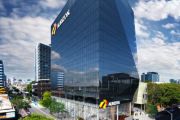
NSW the powerhouse of commercial construction in Australia
The non-residential building industry is in for a ”bumper year”, driven largely by activity in NSW, according to forecaster BIS Oxford Economics.
Demand for Sydney office space and the commencement of major infrastructure projects, such as the building of stations for the North West rail project, will be responsible for most of the growth, according to BIS Oxford Economics managing director Robert Mellor, who was speaking at the forecaster’s Building Industry Prospects conference on Thursday.
“Office construction is very strong. There’s been an underbuild of offices for years here in Sydney, and there will be very strong conditions for the Sydney office market over the next three or four years,” he said.
That undersupply had been exacerbated by an increasing trend towards residential conversions of office buildings as buyers chased “Manhattan-style living”, the forecaster’s associate director Kim Hawtrey also told the conference.
“Dwelling conversions have tripled in the current cycle,” he said.
Mr Hawtrey said that NSW was largely responsible for the “bumper year” ahead in the commercial sector.
“A bumper year is forecast for non residential [construction] especially in NSW… About 50 per cent of the national total will be in NSW in the coming year,” Mr Hawtrey said.
Total non-residential building projects across Australia are forecast to rise in value by 10 per cent in the 2018 financial year, according to the firm.
Nationally, the value of newly commenced office building projects is predicted to rise by up to 27 per cent in the 2017 financial year and then 41 per cent in the following 12 months.
In Sydney, that figure is 31 per cent for financial year 2017 and then 57 per cent for the financial year 2018. In Melbourne, the second strongest market, it was 33 and 30 per cent respectively.
Away from the office sector, hotels were showing little sign of succumbing to the challenges posed by Airbnb, according to Mr Hawtrey, who said that accommodation providers were consistently reporting occupancy rates of about 80 per cent.
 An artist’s impression of Crown’s 90-storey tower, set to be Melbourne’s tallest building. Photo: Supplied
An artist’s impression of Crown’s 90-storey tower, set to be Melbourne’s tallest building. Photo: Supplied
“Hotels are one of the stories to watch. They’re going to perform well this year and continue to do so next year. (That’s) being driven by international tourism from China, Korea, Japan and Taiwan in the last 12 months,” he said.
High net migration figures were also helping to drive the sector, Mr Hawtrey said.
“We’re seeing more people visiting family in Australia (who have migrated here).”
The value of new hotel projects nationally is expected to increase by 19 per cent in the 2017 financial year.
Mr Mellor pointed to Crown’s planned hotel project in Melbourne as a prominent example of activity expected in the sector in coming years.










